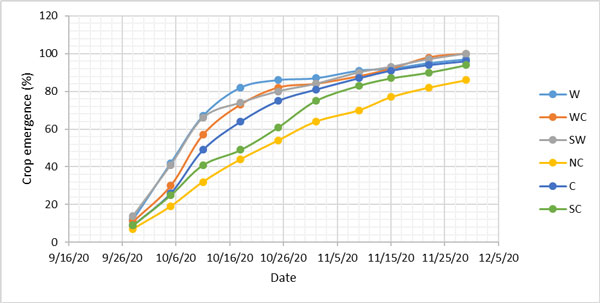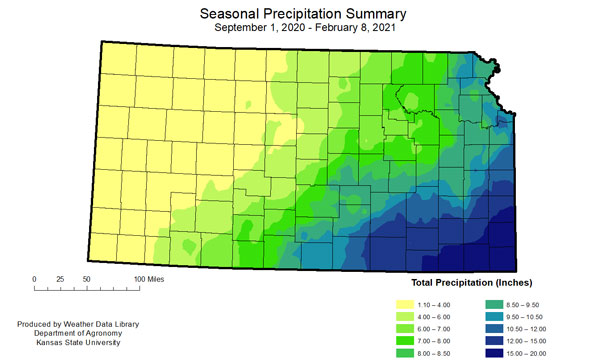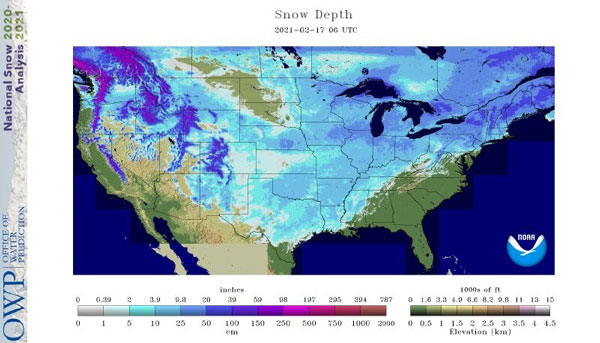The extremely cold temperatures observed in Kansas in mid-February 2021 have the potential to cause winterkill to the winter wheat crop. However, several factors determine whether winter wheat will actually survive the winter. The most important factors from the crop’s perspective include proper cold hardening and root system development, as well as the overall crop status in terms of damage from pests. From an environmental perspective, important factors include air temperature and the consequent soil temperature at the crown level, as well as snow cover and soil moisture content.
Crop condition
The crop conditions of the Kansas wheat crop are variable depending on region and planting date. Some of the fields planted early were able to capitalize on a few rainfall events that happened mid -September and attain a good stand establishment and early development. For the large majority, these would include wheat fields planted after a fallow period in western Kansas (about 57-66% of the crop in western Kansas, Figure 1), and after a wheat or after a canola crop in central Kansas (about 32-49% of the crop in central Kansas, Figure 1). For the most part, these fields emerged by the first week of October (Figure 1) and were able to produce a good number of tillers, as well as good root development, improving its winterhardiness. The remainder of the crop around the state was likely planted after corn in western Kansas or after soybeans in central Kansas. Even if these fields were planted relatively on time (i.e., sometime in October in central Kansas), the emergence rate was considerably lower due to a lack of precipitation during October and into November. Consequently, as much as 36% of the Kansas crop emerged as late as November, depending on the region of the state (Figure 1). These fields had a much more limited development in the fall both in terms of tillers and root, owing to a combination of a late emergence and cool and dry weather conditions. Thus, fields in this condition will be more exposed to potential consequences of the cold temperatures.

Figure 1. Percent emergence of winter wheat as a function of date for the six major winter wheat producing regions of Kansas: West, West Central, Southwest, North Central, Central, and South Central. Data courtesy of USDA-NASS.
The dry conditions experienced during October and into November extended through the winter wheat growing season for the majority of western and central Kansas – except for the south central and southeast portions of the state (Figure 2). In fact, total precipitation from September 1, 2020 through February 8, 2021 (prior to the extreme cold temperatures) was less than 4 inches for a large portion of the wheat growing region in Kansas (Figure 2), which decreased crop growth and development during the fall and early winter.
A well-developed crop, in fields that emerged in mid-September to early-October, can handle air temperatures during the winter in the single digits fairly well. However, soil temperatures at the single digits can cause significant damage and winterkill. A less developed crop, such as that fields emerged in late October or afterwards, will be more sensitive to winterkill with higher temperature thresholds for damage.

Figure 2. Total precipitation during the winter wheat growing season (September 1, 2020 – February 8, 2021) for Kansas. Map courtesy of the Kansas Weather Data Library.
Weather conditions: Air and soil temperatures
The lowest air temperatures ranged from -11°F in south central Kansas to -29°F in north central Kansas, with the majority of the temperatures in northwest Kansas ranging from -18 to -26°F (Figure 3). These temperatures would be low enough to cause leaf burn and, if soil temperatures reached these levels, winterkill. While average soil temperatures in in the February 10-17 period were usually above 20°F (data not shown), the lowest soil temperatures dropped as low as 5 to 14°F (Figure 3). Soil temperatures in the low teens or single digits occurred mostly in northwest Kansas, but were also present in parts of southwest and central Kansas.


Figure 3. Lowest air temperatures (upper panel) and soil temperatures (lower panel) measured in the period between the last time a 32°F measurement occurred and February 17, 2021. Map courtesy of the Kansas Weather Data Library.
Weather conditions: Soil moisture and snow cover
Two environmental factors that affect the crop’s response to cold temperatures due to their potential of buffering of low air temperatures are soil moisture content and snow cover. The dry spell observed in central, north central, and western Kansas prior to the cold spell (Figure 2) also resulted in very low topsoil moisture (data not shown), which did not help in buffering the lower air temperatures.
Regarding snow cover, the majority of the wheat growing region of Kansas received from 1 to 2 inches of snow, with the extreme north and southern borders receiving up to ~4 inches but the central portion of the state receiving virtually no snowfall (Figure 4). Reports also suggest that this snow was relatively dry and light-weight, decreasing its buffering potential, especially compared to the totals achieved in the neighboring states of Oklahoma (up to 10 inches) and Nebraska (up to 20 inches). Regions receiving 1-2 inches of snow probably had some buffering of the low air temperatures and may have helped in the current spell. For example, stations where snowfall was reported had lowest minimum soil temperatures of ~24-28°F, versus 15 degrees reported in a neighboring station without snowfall. Still, the combination of extremely cold air temperatures and dry soils, with a limited amount of snow across the majority of the state, might have caused damage to some fields.

Figure 4. Snow depth as of February 17, 2021 as reported by the National Oceanic and Atmospheric Administration.
What is the potential for damage and what to look for?
The biggest potential for winterkill is in fields that emerged late (thus, with limited tiller and root development), where snow cover was limited (<2 inches), and in regions which soil temperatures reached low teens to single digits. Some of the regions of concern seem to be central Kansas (due to limited snow depth) and northwest Kansas (due to extremely cold temperatures). The conditions were less prone to winterkill in south central Kansas due to greater levels of soil moisture and snow depth.
The next 4-6 weeks will be crucial to determine the recovery potential of the crop. Ideally, precipitation would alleviate the current dry conditions and temperatures would warm up slowly so that the crop can start spring development. Continuation of the dry conditions can further impair crop recovery.
There is nothing growers can do at the moment, other than wait until green-up for further evaluation of the crop. As wheat green-up progresses, any winter injury will become more apparent. Injured wheat may initially green up, then go backwards.
Romulo Lollato, Extension wheat and forage specialist
lollato@ksu.edu
Mary Knapp, Weather Data Library
mknapp@ksu.edu
Tags: wheat winter hardiness winter survival cold temperatures